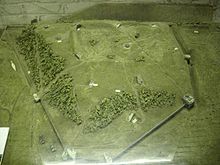Liège Fortress Ring

The first modern fortresses around the Belgian city of Liège were built between 1880 and 1890. Its establishment goes back to the Belgian general Henri Alexis Brialmont . The fortresses were designed as forts at a distance of about seven kilometers from downtown Liège. All of these forts were built with concrete and equipped with the most modern weapons of the time.
List of the twelve forts before the First World War
Starting in the north on the right bank of the Meuse :
- Barchon as a great fort
- Evegnée as a small fort
- Fléron as a great fort
- Chaudfontaine as a small fort
- Embourg as a small fort
- Boncelles as a great fort
- Flémalle as a great fort
- Hollogne as a small fort
- Loncin as a great fort
- Lantin as a small fort
- Liers as a small fort
- Pontisse as a great fort
For appearance, armament and crew, see Fort Loncin .
The fighting in the First World War
At the beginning of the First World War, the forts were still considered to be insurmountable; Nevertheless, the German attackers shot them down with the so-called Fat Bertha within a very short time . The end of this hopeless struggle was the explosion of Fort Loncin .
Interwar period
During this time frame the reconstruction of the eight south, east and north facing forts fell. The west facing plants were taken out of active service. Rebuilding Loncin was out of the question. Instead, four more plants were built in the east, this time at a distance of 20 kilometers from downtown Liège.
List of forts prior to World War II
Starting in the north
- Fort Eben-Emael
- Aubin-Neufchâteau
- Battice
- Tancremont or Pepinster
- Sougné-Remouchamps (only projected)
In addition, a large number of smaller bunker systems were built or planned in several lines along the border.
The fighting in World War II
The Belgian generals had given Fort Eben-Emael the important task of strategically securing the northern border of the country, so the fort first of all attracted the German attackers.
The campaign in the west began on May 10, 1940 at 5:35 a.m. with actions by the Airborne Corps ( Army Group B ) under its commanding General Kurt Student . In addition to Fort Eben-Emael (part of the Belgian border fortifications on the Albert Canal ), they mainly attacked and occupied bridges and airfields in the depths of the area. Rapid access, at least in Holland, was intended to prevent Allied intervention and split up the defense forces. The targets were taken almost everywhere, but often with heavy losses. Numerous strategically important bridges in Belgium and the Netherlands were secured by small troops' command operations shortly before the start of the surprise attack until regular German ground forces arrived (→ Brandenburg (special unit) ).
A commando company (see Battle of Fort Eben-Emael ) of 56 paratroopers of the 7th Flieger-Division (Kampfgruppe Granit (Oberleutnant Witzig )) was able to take the very large fort within hours. They ended up with seven gliders the Air Force on the plateau.
After the conquest, the attackers were able to bypass the Liège fortress ring. Nevertheless, other works soon fell into the hands of the attackers, for example on May 22, 1940 - after five days of siege - the Battice and Aubin-Neufchâteau forts .
During the further course of the Second World War served Eben-Emael the Nazi propaganda ; some of the other forts were testing new weapons.
The forts today
Fort Loncin is now a military cemetery and memorial with an attached museum.
The other forts are partly built over (e.g. Fléron , Pontisse ) and therefore no longer visible, while others still serve as a camp for the Belgian military (partly in Eben-Emael ). The other forts are also still owned by the military, which is why there are still signs prohibiting entry, but the fences have been partially removed and the site is used for other purposes (e.g. Battice ). The steel parts of some forts have been scrapped and the forts are simply overgrown (e.g. Aubin-Neufchâteau ).
There is also a museum in Eben-Emael , the site is otherwise used for agriculture. The steel domes and guns are partly still there. Battice is now home to pasture land, a model airfield and a private shooting range; the indoor facilities can be visited with a guide. This also applies to Tancremont , Barchon , Liers and others.
See also
literature
- Clayton Donnell: The forts of the Meuse in World War I. Osprey, Oxford et al. 2007, ISBN 978-1-84603-114-4 ( Fortress 60).
- JE Kaufmann, Robert M. Jurga: Fortress Europe. European fortifications of World War II. Da Capo Press, Cambridge MA 2002, ISBN 0-306-81174-X , pp. 99-126.


